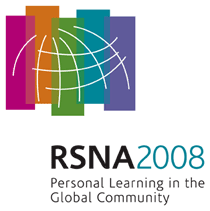
Abstract Archives of the RSNA, 2008
Takayuki Masui MD, Presenter: Nothing to Disclose
Motoyuki Katayama MD, Abstract Co-Author: Nothing to Disclose
Kimihiko Sato MD, Abstract Co-Author: Nothing to Disclose
Hiroki Ikuma MD, Abstract Co-Author: Nothing to Disclose
Hidekazu Seo MD, Abstract Co-Author: Nothing to Disclose
Haruyuki Fukuchi, Abstract Co-Author: Nothing to Disclose
Kenji Asano, Abstract Co-Author: Nothing to Disclose
Megumi Ishii, Abstract Co-Author: Nothing to Disclose
Humihiro Tako RT, Abstract Co-Author: Nothing to Disclose
Shun Imamura RT, Abstract Co-Author: Nothing to Disclose
Hasnine Akter Haque DSc, Abstract Co-Author: Nothing to Disclose
et al, Abstract Co-Author: Nothing to Disclose
Firstly to evaluate feasibility of fat measurements using dual echo GRE based on Dixon method and proton Spectroscopy in the phantom, secondly to show reproducibility of fat measurements of the liver with two MR methods with one week’s interval, thirdly to monitor changes of fat contents in the liver of the subjects with metabolic syndrome for 6 months after initial medical check ups.
Firstly, in-phase and fat images with 3D Multi-Echo with 2-Point Dixon Reconstruction for Decomposition of Aqua/Lipid (MEDAL)(GE) and proton Spectroscopy based on PRESS were acquired for evaluation of phantoms containing various mount of fat and water during 26 and 21sec, respectively. Secondly, 32 volunteers (mean 32.2 years old) underwent breath-hold 3D MEDAL and single voxel proton Spectroscopy for liver, twice with one week’s interval. Thirdly, nine candidate of metabolic syndrome underwent MR fat measurements 1, 3 and 6 months after medical checkups. Fat fraction was calculated by SI of ROI on fat image/that of in phase image with MEDAL and with proton Spectroscopy, peak areas were calculated using Lorenzian curve fit with Marquard algorithm and fat fraction was obtained. Correlations of fat fraction with MEDAL and Spectroscopy and between on repeated measurements were evaluated with linear regression analysis.
In phantom, good correlation was obtained between fat contents and calculated fat fraction of MEDAL (R2=.879) and Spectroscopy (R2=.991), respectively. In 32 volunteers, reproducible fat measurements with one week’s interval were observed in both MEDAL (R2=.967) and Spectroscopy (R2=.894), respectively. Correlation was acceptable between in MEDAL and Spectroscopy (R2=0.654). In three of nine subjects with metabolic syndrome, gradual decrease in fat fraction was observed. In two subjects, increase of fat fraction was observed. Mean fat fraction of nine subjects slightly decreased from 11.8% to 9.4% during 6 months.
Accurate MR measurements of fat fraction of phantom were demonstrated. With MEDAL and Spectroscopy, reproducible and well-correlated fat measurements in the liver can be performed with a breath-hold. Both MR methods can be used for monitoring fat fraction of the liver.
Breath-hold MEDAL and proton Spectroscopy provide quantitative fat fraction of the liver, which can be used for monitoring status of hepatic fat contents non-invasively.
Masui, T,
Katayama, M,
Sato, K,
Ikuma, H,
Seo, H,
Fukuchi, H,
Asano, K,
Ishii, M,
Tako, H,
Imamura, S,
Haque, H,
et al, ,
Fast MR Measurements of Fat Fraction of the Liver Using MEDAL and Proton Spectroscopy. Radiological Society of North America 2008 Scientific Assembly and Annual Meeting, February 18 - February 20, 2008 ,Chicago IL.
http://archive.rsna.org/2008/6020557.html

